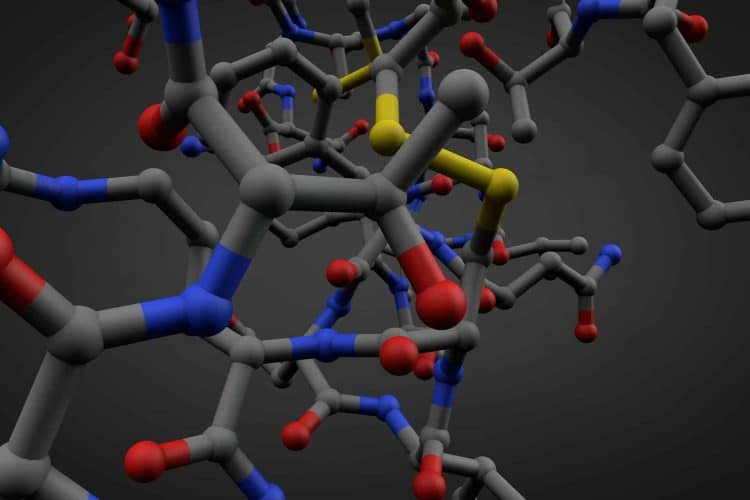Polymers are very large molecules composed of repeating chemical units called monomers (poly: multiple; mers: units or monomers). The size of polymers and their ability to intermingle confer unique material properties. Polymers are ubiquitous in nature and society; they form proteins, cellulose, plastic, and rubber, to mention a few. Polymers produced by living organisms or created from natural materials are referred to as biopolymers. An overreliance on man-made petroleum polymers (i.e., non-biodegradable plastics) has pushed researchers and innovators to consider renewable biopolymer alternatives, including those that utilize hemp as their starting material. [1]
The most significant application of hemp in the world of polymer materials is that of biocomposites. [1] Biocomposite refers to a combination (composite) of materials that generates a new, enhanced material. Conventional manufacturing amalgamates fiberglass to mold and strengthen polymers (e.g., plastics). Hemp is emerging as an environmentally-friendly, cost-effective alternative. [2] BMW, for example, uses hemp biocomposite in the door trims and dashboard of its BMW i3/i3s. The 718 Cayman GT4 Clubsport from Porsche integrates hemp biocomposite into door panels.
Chopped hemp fiber has been shown to effectively reinforce biopolymers through infusion into cellulose-based plastic. [3] This means that hemp fiber can give plant-based plastic its strength and shape. The same is true for synthetic plastics. Modulating hemp fiber alignment, length, and diameter decreases or increases material strength and stiffness. Stiffness and specific tensile strength comparable to commercial fiberglass can be achieved. [4]
For strength and stiffness, the best-suited biodegradable matrix material for hemp appears to be polylactide (PLA), a polyester created from renewable biopolymers (e.g., cornstarch or sugar cane). [4] PLA and hemp (as the biocomposite) are used for 3D printer filaments. Hemp has also been shown to increase hardness and tearing strength in natural rubber. [5] Further, researchers have examined hemp biocomposite in concrete; they concluded that it may increase fire resistance. [6]
Durability against moisture (due to hydrophilic properties) is one problem associated with hemp biocomposite. In 2019, research published in the journal Polymers found that hybridizing hemp fibers with basalt fibers decreased water uptake by up to 75%. [7] Moisture buffers (such as clay-based paint) and nanocellulose formulations are among other strategies designed to overcome this challenge. [8,9]
Hypothetically, hemp cellulose could act as a biopolymer for a matrix (e.g., PLA); this application is very rare, however. The Australian company Zeoform blends the cellulose of hemp, corn, and other agricultural waste to produce commercial and industrial materials. The Hemp Plastic Company combines hemp fiber with PLA and other biodegradable polymers for “hemp plastic solutions.”
It’s important to point out that researchers and manufacturers are not generally transforming hemp cellulose into biopolymer matrix material. Rather, the idea of “hemp-based plastic” mostly refers to hemp-fiber biocomposite, which provides structure and strength to plant-derived or synthetic plastics. It may also be cost ineffective and/or inappropriate to source cellulose from hemp on a large scale or for every application; opinions are divided on this matter. Perhaps someday hemp will shine as the standalone resource for biopolymers. At present, hemp serves as a cheap, renewable biocomposite to structure and reinforce.
References:
- Mohanty, Amar, et al. “Sustainable Bio-Composites from Renewable Resources: Opportunities and Challenges in the Green Materials World.” Journal of Polymers and the Environment, vol. 10, 2002, doi:10.1023/A:1021013921916. Journal Impact Factor = 1.971, Times Cited = 1,358 (ResearchGate)
- Joshi, Satish, et al. “Are Natural Fiber Composites Environmentally Superior to Glass Fiber Reinforced Composites? Compos A.” Composites Part A: Applied Science and Manufacturing, vol. 35, 2004, doi:10.1016/j.compositesa.2003.09.016. Journal Impact Factor = 4.514, Times Cited = 1,130 (ResearchGate)
- Wibowo, Arief C., et al. “Chopped Industrial Hemp Fiber Reinforced Cellulosic Plastic Biocomposites: Thermomechanical and Morphological Properties.” Industrial & Engineering Chemistry Research, vol. 43, no. 16, Aug. 2004, pp. 4883–88, doi:10.1021/ie030873c. Journal Impact Factor = 3.14, Times Cited = 39 (ResearchGate)
- Pickering, K. L., et al. “A Review of Recent Developments in Natural Fibre Composites and Their Mechanical Performance.” Composites Part A: Applied Science and Manufacturing, vol. 83, 2016, pp. 98–112, doi:https://doi.org/10.1016/j.compositesa.2015.08.038. Journal Impact Factor = 4.514, Times Cited = 540 (ResearchGate)
- Stelescu, Maria, et al. “New Green Polymeric Composites Based on Hemp and Natural Rubber Processed by Electron Beam Irradiation.” The Scientific World Journal, vol. 2014, 2014, doi:10.1155/2014/684047. Journal Impact Factor = 0.98, Times Cited = 21 (ResearchGate)
- Netinger, Ivanka, et al. “Effect of Hemp Fibers on Fire Resistance of Concrete.” Construction and Building Materials, vol. 184, 2018, doi:10.1016/j.conbuildmat.2018.07.014. Journal Impact Factor = 2.51, Times Cited = 1 (ResearchGate)
- Sergi, Claudia, et al. “Durability of Basalt/Hemp Hybrid Thermoplastic Composites.” Polymers, vol. 11, 2019, doi:10.3390/polym11040603. Journal Impact Factor = 2.935
- Latif, Eshrar, et al. “Moisture Buffer Potential of Experimental Wall Assemblies Incorporating Formulated Hemp-Lime.” Building and Environment, vol. 93, 2015, pp. 199–209, doi:https://doi.org/10.1016/j.buildenv.2015.07.011. Journal Impact Factor = 4.539, Times Cited = 39 (ResearchGate)
- Ansari, Farhan, et al. “Cellulose Nanofiber Network for Moisture Stable, Strong and Ductile Biocomposites and Increased Epoxy Curing Rate.” Composites Part A: Applied Science and Manufacturing, vol. 63, 2014, pp. 35–44, doi:https://doi.org/10.1016/j.compositesa.2014.03.017. Journal Impact Factor = 4.514, Times Cited = 62












